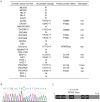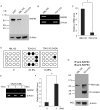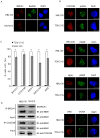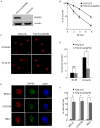Loss of BRCA1-A complex function in RAP80 null tumor cells
- PMID: 22792303
- PMCID: PMC3391255
- DOI: 10.1371/journal.pone.0040406
Loss of BRCA1-A complex function in RAP80 null tumor cells
Abstract
Receptor Associated Protein 80 (RAP80) is a subunit of the BRCA1-A complex and targets BRCA1 to DNA damage sites in response to DNA double strand breaks. Since mutations of BRCA1 are associated with familial ovarian cancers, we screened 26 ovarian cancer-derived cell lines for RAP80 mutations and found that TOV-21G cells harbor a RAP80 mutation (c.1107G >A). This mutation generates a stop codon at Trp369, which deletes the partial AIR region and the C-terminal zinc fingers of RAP80. Interestingly, both the mutant and wild type alleles of RAP80 lose their expression due to promoter hypermethylation, suggesting that TOV-21G is a RAP80-null cell line. In these cells, not only is the BRCA1-A complex disrupted, but the relocation of the remaining subunits in the BRCA1-A complex including BRCA1, CCDC98, NBA1, BRCC36 and BRE is significantly suppressed. Moreover, TOV-21G cells are hypersensitive to ionizing radiation, which is due to the compromised DNA damage repair capacity in these cells. Reconstitution of TOV-21G cells with wild type RAP80 rescues these cellular defects in response to DNA damage. Thus, our results demonstrate that RAP80 is a scaffold protein in the BRCA1-A complex. Identification of TOV-21G as a RAP80 null tumor cell line will be very useful for the study of the molecular mechanism in DNA damage response.
Conflict of interest statement
Figures




References
-
- American Cancer Society. Global cancer facts & figures 2007. Atlanta, Ga.: American Cancer Society. 46 p. 2007.
-
- King MC, Marks JH, Mandell JB. Breast and ovarian cancer risks due to inherited mutations in BRCA1 and BRCA2. Science. 2003;302:643–646. - PubMed
-
- Narod SA, Foulkes WD. BRCA1 and BRCA2: 1994 and beyond. Nat Rev Cancer. 2004;4:665–676. - PubMed
Publication types
MeSH terms
Substances
Grants and funding
LinkOut - more resources
Full Text Sources
Miscellaneous

